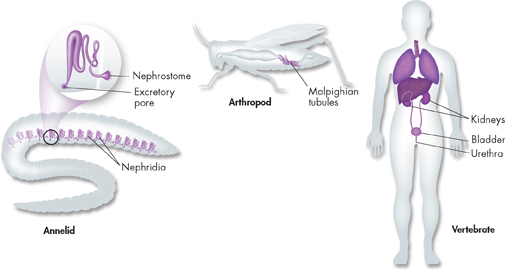Excretion in Terrestrial Animals
 How do land animals remove wastes while conserving water?
How do land animals remove wastes while conserving water?
Land animals also face challenges. In dry environments, they can lose large amounts of water from respiratory membranes that must be kept moist. In addition, they must eliminate nitrogenous wastes in ways that require disposing of water—even though they may not be able to drink water. Figure 27–16 shows the excretory systems of some terrestrial animals.
Terrestrial Invertebrates  Some terrestrial invertebrates, including annelids and mollusks, produce urine in nephridia. Nephridia (singular: nephridium) are tubelike excretory structures that filter body fluid. Typically, body fluid enters the nephridia through openings called nephrostomes and becomes more concentrated as it moves along the tubes. Urine leaves the body through excretory pores.
Some terrestrial invertebrates, including annelids and mollusks, produce urine in nephridia. Nephridia (singular: nephridium) are tubelike excretory structures that filter body fluid. Typically, body fluid enters the nephridia through openings called nephrostomes and becomes more concentrated as it moves along the tubes. Urine leaves the body through excretory pores.  Other terrestrial invertebrates, such as insects and arachnids, convert ammonia into uric acid. Nitrogenous wastes, such as uric acid, are absorbed from body fluids by structures called Malpighian tubules, which concentrate the wastes and add them to digestive wastes traveling through the gut. As water is absorbed from these wastes, they form crystals that form a thick paste, which leaves the body through the anus. This paste contains little water, so this process minimizes water loss.
Other terrestrial invertebrates, such as insects and arachnids, convert ammonia into uric acid. Nitrogenous wastes, such as uric acid, are absorbed from body fluids by structures called Malpighian tubules, which concentrate the wastes and add them to digestive wastes traveling through the gut. As water is absorbed from these wastes, they form crystals that form a thick paste, which leaves the body through the anus. This paste contains little water, so this process minimizes water loss.
Quick Lab
GUIDED INQUIRY
Water and Nitrogen Excretion

Label one test tube Urea and the other Uric Acid. Place 2 grams of urea in the one labeled Urea. Place 2 grams of uric acid in the one labeled Uric Acid.
Add 15 mL of water to each test tube. Stopper and shake the test tubes for 3 minutes.
Observe each test tube. Record your observations.
Observe Which substance—urea or uric acid—is less soluble in water? Explain.
Infer Reptiles excrete nitrogenous wastes in the form of uric acid. How does this adaptation help reptiles survive on land?
Analyze and Conclude
Terrestrial Vertebrates In terrestrial vertebrates, excretion is carried out mostly by the kidneys.  Mammals and land amphibians convert ammonia into urea, which is excreted in urine. In most reptiles and birds, ammonia is converted into uric acid. Reptiles and birds pass uric acid through ducts into a cavity that also receives digestive wastes from the gut. The walls of this cavity absorb most of the water from the wastes, causing the uric acid to separate out as white crystals. The result is a thick, milky-white paste that you would recognize as “bird droppings.”
Mammals and land amphibians convert ammonia into urea, which is excreted in urine. In most reptiles and birds, ammonia is converted into uric acid. Reptiles and birds pass uric acid through ducts into a cavity that also receives digestive wastes from the gut. The walls of this cavity absorb most of the water from the wastes, causing the uric acid to separate out as white crystals. The result is a thick, milky-white paste that you would recognize as “bird droppings.”

FIGURE 27–16 Excretion in Terrestrial Animals Some terrestrial invertebrates, such as annelids, rid their bodies of ammonia by releasing urine created in their nephridia (left). Some insects and arachnids have Malpighian tubules, which absorb uric acid from body fluids and combine it with digestive wastes (above). In vertebrates, such as humans, excretion is carried out mostly by the kidneys (right).
dTable of Contents
- Formulas and Equations
- Applying Formulas and Equations
- Mean, Median, and Mode
- Estimation
- Using Measurements in Calculations
- Effects of Measurement Errors
- Accuracy
- Precision
- Comparing Accuracy and Precision
- Significant Figures
- Calculating With Significant Figures
- Scientific Notation
- Calculating With Scientific Notation
- Dimensional Analysis
- Applying Dimensional Analysis




